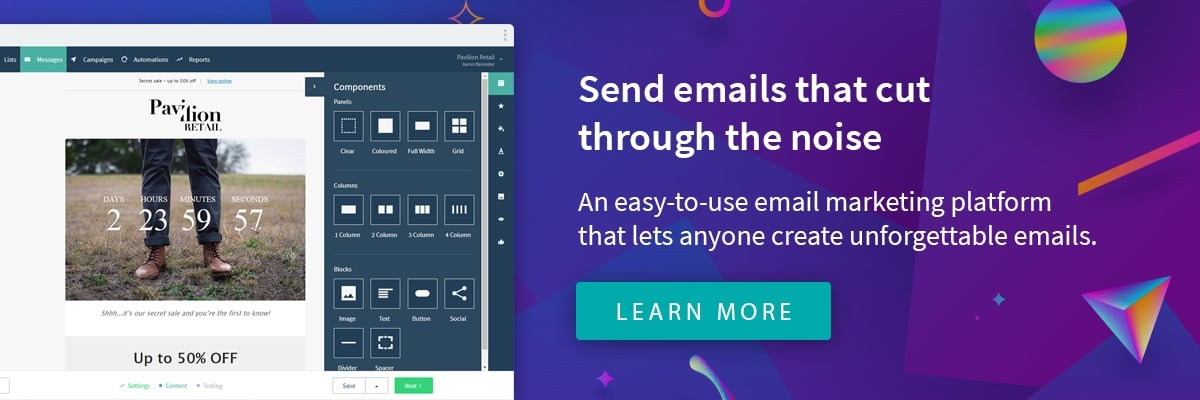Tracking email metrics is a vital for measuring success, honing your strategy, optimising campaigns, and driving better results.
In this blog post, we explore the ten key email metrics you should measure to best assess your email marketing performance.
1. Open rates
You’ll want to be measuring the open rate of every email campaign you send.
We email to let people know about something that we believe is of value. That could be a new product or promotion, or important information that your customers need to know about.
Whatever you’re promoting, you’re going to want the recipient to open the email to find out more.
Measuring open rate is a good indicator of how successful your subjects line are and whether you’re sending to a relevant audience.
2. Click-to-open rates
Open rates are valuable if you’re measuring the result of an A/B test, or are comparing the performance of your emails over time. But for most campaigns, the click-to-open rate is the vital measure of engagement.
Measuring click-to-open rate shows you how subscribers are engaging with the content within your email. It helps you judge whether your calls to action have been strong enough to entice people to take the next step.
Click-through rates can help you understand the type of content and offers, your subscribers are most interested in, and the language that compels them to click.
Having an understanding of this tells you much more about how to improve your email marketing than open rates alone.
4. Click-through rates
Click-through rates will give you a wider view of how well a single campaign has compelled people to take action.
It will allow you to understand how your subject lines and email content are working together to drive people to your website.
5. Conversion rates
Once you’ve analysed engagement with the content of your emails, you’ll want to examine what people are doing once they reach your site.
Was the call to action in your email directing them to a specific product on your site? If so, did they convert and buy this product?
Measuring conversion rates helps you to judge if the engaging content in your email (that compelled your subscribers to click) is matched by the experience on your website.
Conversion rate is a crucial eCommerce metric. If you find you’re driving a large number of people through to your site—but they aren’t converting—consider what you can improve to ease them towards purchase.
Look to the big eCommerce players like Amazon for lessons in how to improve customer experience and remove conversion blockers.
We also explored ways to increase conversions at a recent event.
6. Revenue per click
Having worked out your conversion rates, take a look at the value of the conversions themselves.
Take the total value of sales generated from clicks through from your email campaign. Divide this buy the total number of clicks through to your website the campaign earned. This allows you to work out your earnings per click.
Earnings per click helps you put a value on how important it is to make your email content engaging enough to entice a click-through.
Having this kind of metric in your reporting arsenal will help you to rationalise time and resources spent on email marketing when compared to other channels.
7. Revenue per campaign
Measuring the revenue generated by each email campaign will help you keep a track of the overall return on investment (ROI) of your email marketing. It’ll help you understand which types of email campaigns were impacting your bottom line. It’s great fodder to report back to the business and to leadership.
It’ll also help you pinpoint seasonal trends that can inform future campaigns. You might find that certain types of campaigns drove more revenue during the festive season.
8. Unsubscribe rates
No matter how great your email marketing messages are, people will unsubscribe.
While it’s not worth taking to heart, your unsubscribe rate is definitely a metric you need to track.
High unsubscribe rates might suggest that you’re sending too frequently or your emails aren’t relevant to your recipients.
Segmenting email campaigns by the level of previous engagement, demographics, and personal preferences can help you maintain a healthy subscribe rate.
9. Delivery rates
Delivery rates show how many of your emails are landing in people’s inboxes.
Many factors influence deliverability. A low rate might be a result of a unclean email list containing invalid email adresses.
It could be that your email contained phrases that didn’t make it past spam filters.
In a worst-case scenario, low delivery rates could mean that the IP address associated with your emails has a bad reputation. We’ve written a handy guide that explains all the factors that influence delivery rates, along with practical advice on how to improve deliverability.
10. Bounce rates
There are two types of bounces you will encounter within your email campaign.
A ‘soft bounce’ means that the email reached the recipient’s mail server but didn’t land in their inbox. That could be because the mail server was down, the recipient’s inbox was full, or the message was too large due to hefty images and animated gifs.
A ‘hard bounce’ is when the email address doesn’t exist or is invalid.
A high hard bounce rate could be a sign that you’re email list is starting to get dated or that it wasn’t very clean to begin with. ‘Hard bounces’ are common in B2B email marketing where email addresses are deleted after people leave companies.
Takeaway
Using these metrics to measure the success of your email marketing will help you refine and improve your strategy.
Marketing is iterative and only by learning from what worked (and what didn’t) can you create better campaigns and improve your results.

